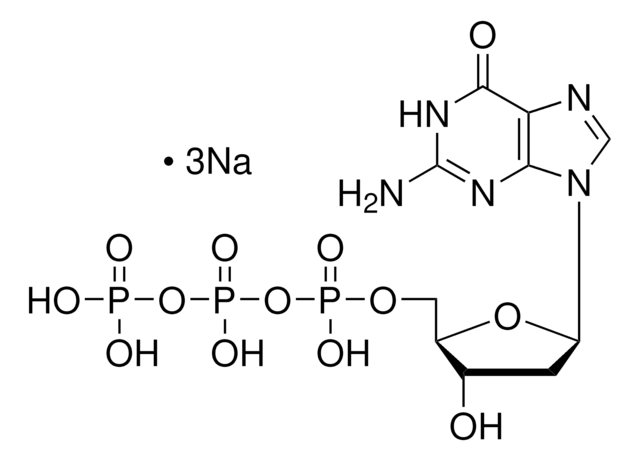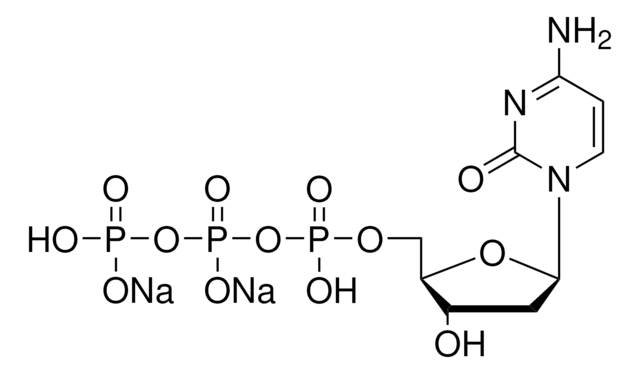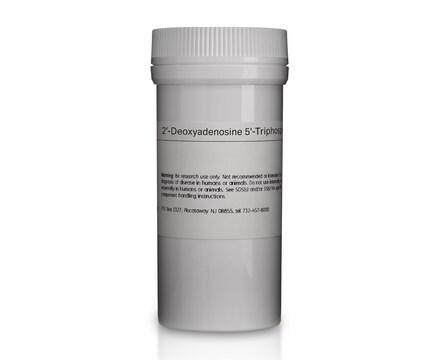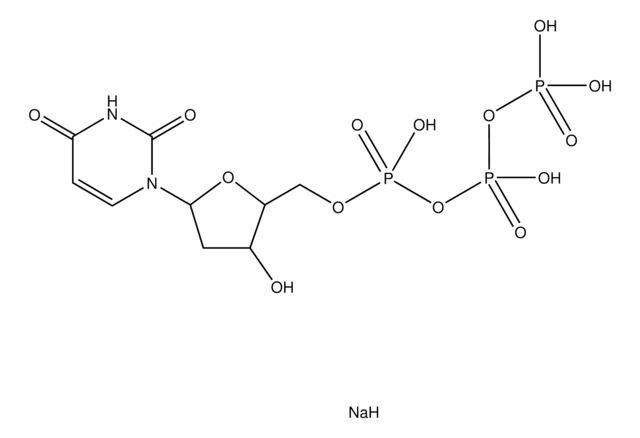DCTP-RO
Roche
dCTP
99% (dNTP), <0.9% (dNDP), solution, 100 mM
Sinónimos:
2′-Deoxycytidine 5′-triphosphate disodium salt, dCTP-Na2
About This Item
Productos recomendados
descripción
PCR Grade, sodium salt
Nivel de calidad
Ensayo
99% (dNTP)
Formulario
solution
uso
sufficient for 125,000 standard reactions (03732690001)
sufficient for 31,250 standard reactions (11969021001)
sufficient for 6,250 standard reactions (11934520001)
envase
pkg of 1,250 μL (11969021001 [100 mM])
pkg of 4 × 1,250 μL (03732690001 [4x100 mM])
pkg of 250 μL (11934520001 [100 mM])
fabricante / nombre comercial
Roche
concentración
<0.9% (dNDP)
100 mM
temp. de almacenamiento
−20°C
cadena SMILES
[Na+].[Na+].NC1=NC(=O)N(C=C1)[C@H]2C[C@H](O)[C@@H](COP(O)(=O)OP([O-])(=O)OP(O)([O-])=O)O2
InChI
1S/C9H16N3O13P3.2Na/c10-7-1-2-12(9(14)11-7)8-3-5(13)6(23-8)4-22-27(18,19)25-28(20,21)24-26(15,16)17;;/h1-2,5-6,8,13H,3-4H2,(H,18,19)(H,20,21)(H2,10,11,14)(H2,15,16,17);;/q;2*+1/p-2/t5-,6+,8+;;/m0../s1
Clave InChI
ABWVCNMFYVEBIB-CDNBRZBRSA-L
¿Está buscando productos similares? Visita Guía de comparación de productos
Categorías relacionadas
Descripción general
Aplicación
Calidad
Forma física
Nota de preparación
Otras notas
Código de clase de almacenamiento
12 - Non Combustible Liquids
Clase de riesgo para el agua (WGK)
WGK 1
Punto de inflamabilidad (°F)
does not flash
Punto de inflamabilidad (°C)
does not flash
Elija entre una de las versiones más recientes:
¿Ya tiene este producto?
Encuentre la documentación para los productos que ha comprado recientemente en la Biblioteca de documentos.
Los clientes también vieron
Nuestro equipo de científicos tiene experiencia en todas las áreas de investigación: Ciencias de la vida, Ciencia de los materiales, Síntesis química, Cromatografía, Analítica y muchas otras.
Póngase en contacto con el Servicio técnico










